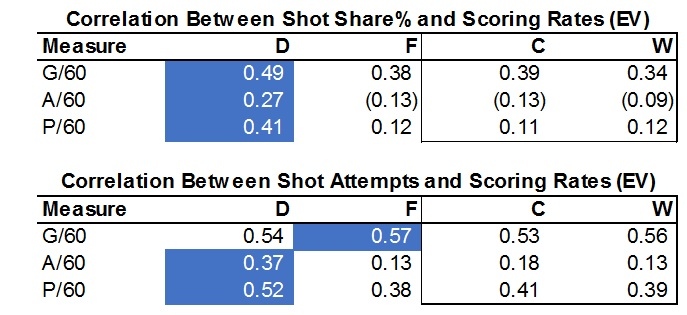Jul 16, 2018
How much should we care about defencemen scoring rates?
The numbers show a blueliner’s point total doesn’t necessarily measure his true offensive impact, Travis Yost writes.
By Travis Yost

What happens when scoring rates aren’t particularly reflective of the offensive value a player is providing?
It's a paradox that National Hockey League front offices have been dealing with for quite some time – in particular with defencemen. For as long as hockey has been around, the hockey world has generally drawn a straight line between point accumulation and offensive impact. The more points a player has, the more of an offensive impact he is having. And the more offensive impact he is having, the more valuable that player is to his team’s offensive production.
It seems logical in theory, but doesn't hold up as well under a microscope. A lot of the issue has to do with the fact that scoring from forwards is quite different than scoring from defencemen.
What do I mean? Let’s start at the foundation of how goals are scored. You can’t score a goal without a shot. But there is only one puck on the ice at all times and every shot is a decision point. It’s reasonable to infer that when players shoot, the opportunity cost of passing to a teammate (or a number of other hockey plays) is less than the value of the immediate chance at scoring a goal.
Naturally, one would conclude that the more a player shoots, the more chance he has at picking up a goal or an assist on the scoring chance, and that’s true. But what’s interesting is that individual shot rates and the percentage of shots taken by the player while on the ice are more predictive of scoring rates for defencemen, not forwards. (Here, 1.0 would indicate perfect correlation, 0.0 would indicate no correlation, and -1.0 would indicate a perfect inverse correlation.)

The first table shows the relationship between the percentage of shots taken by any individual player and his scoring rates. As you can see, there is a strong relationship between the percentage of shots taken by a defender and the rate at which he accumulates points. For forwards, there is a relationship, but it’s much more concentrated to goal-scoring. There is actually a slightly negative correlation between the percentage of shots a forward takes and the rate at which he picks up assists.
The second table is just as interesting. Shot rates and scoring rates are highly correlated as it pertains to goal-scoring, and is marginally more predictive for forwards than defencemen. But that relationship completely flips for assists. Shot rates and assist rates have a relationship for defenders; for forwards, not so much. There are a multitude of reasons for this, but some of the big ones probably include the fact that defenders are more likely to rack up secondary assists than forwards and that shots from the point are more likely to create rebound and redirect opportunities than shots from in tight.
This is a long way of saying that the more active defencemen are with respect to taking shots in the offensive zone, the more likely they are to accumulate assists.
But here is the issue. We care about shots because they lead to goals. We care about points because we believe the more points a player is accumulating, the more goals he is directly or indirectly creating for his team. Based on the above, you would only be left to conclude that defencemen should shoot as much as possible.
That’s where the issue arises. For forwards, shot totals and point totals correlate reasonably well with the rate in which their respective teams score goals with them on the ice. For defencemen, not so much.

I’m showing both actual goals and expected goals (based on rate and quality of the shots, per Corsica) to emphasize that this isn’t noise. If you knew how active a defenceman was at generating shots, you wouldn’t know how well his team did in terms of generating goals. If you knew how active a forward was at generating shots, you would have a better idea – your confidence, in fact, doubles.
What’s the trick? In part, it’s that defencemen are much more likely to pick up vacuous secondary assists. Not every secondary assist is noise, but a large chunk of them are, and it seems that many of those don’t actually add any value to the goal-scoring sequence.
Perhaps a better way to say this is that if you had to choose between an aggressive attacking forward and an aggressive attacking defenceman, all other talents equal, you would choose the forward. His activity in the offensive zone is much more likely to directly lead to a goal. A defender, not so much. Add that to the fact that every shot a defender takes has an opportunity cost – i.e., a forward taking a shot later in the sequence from perhaps a more dangerous area – and you have an even bigger philosophical argument.
One point that I’d like to emphasize: this doesn’t mean points are irrelevant for defenders. A defenceman with, say, 60 points has surely had a more material impact than a counterpart with 30 points. It’s that we have less confidence about what to do with those 60 points. For forwards, it’s much more indicative of direct influence on the run of play.
That simply doesn’t appear to be as true for defencemen.

